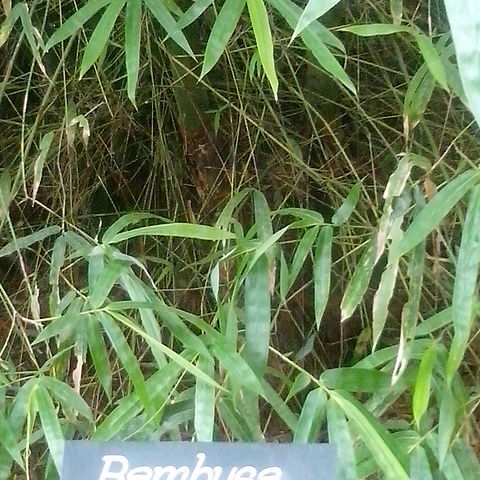Culms to 15 m, 5.5–7.5 cm in diam.; internodes 30–57 cm, initially thinly white powdery and stiffly gray hairy; wall thin; nodes flat, basal nodes usually with a ring of gray-white silky hairs and short aerial roots when old; branching from 6th or 7th node up. Branches many, clustered, central 3 dominant. Culm sheaths deciduous, attenuate, broadly trapezoid, leathery, initially white powdery, glabrous or sparsely deciduously dull brown strigose, apex subtruncate; auricles spreading, subequal, broadly elliptic or suborbicular, small, 5–6 mm wide; oral setae present; ligule very short; blade erect, narrowly triangular, usually longer than sheath, base slightly rounded, slightly narrower than sheath apex, sparsely stiffly deciduously dull brown hairy. Leaf blade linear-lanceolate, 10–20 × 1.2–2 cm, abaxially chalky-white. Pseudospikelets in capitate clusters, glaucous, 2.5–3 cm, gemmiferous bracts present; florets 7–14, basal 1 male, apical 3–5 imperfect; rachilla segments clavate, apex enlarged and ciliate. Glumes 1 or 2, ovate, apex acute; lemma ovate, abaxially glabrous, many veined, adaxially slightly hairy, apex acute, mucronate; palea obviously shorter than lemma, keels ciliate, 3–5-veined between keels; lodicules 3, oblong or narrowly obovate, base thickened, margin ciliate, anterior 2 slightly asymmetrical, posterior symmetrical and smaller. Ovary oblong, tapering; stigmas 3.
More
A large bamboo. It grows in thick clumps. It grows 15 m tall. The stems are olive green. They are 6-8 cm across. The sheath on the stem is broad and straight. The leaves are narrow and 10-20 cm long by 1-2 cm wide. It occasionally flowers with a very large flower cluster.

